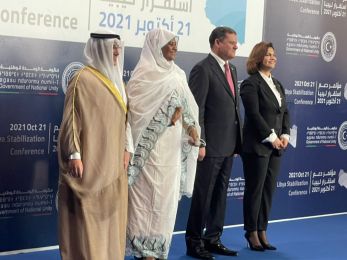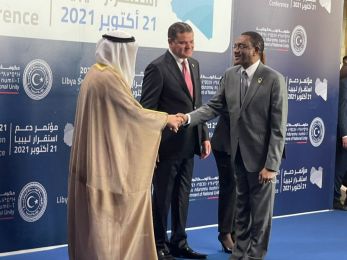PANAPRESS
Panafrican News Agency
Ethiopia: Africa aims to use agric to halve poverty by 2025 (Special Report by Kennedy Abwao, PANA Correspondent, Addis Ababa)
Addis Ababa, Ethiopia (PANA) - Boaz Blackie Keizire, a top agricultural strategist at the African Union (AU), glances at his computer and looks at his phone at the same time. It's time to wind up and proceed to the next meeting on the status of agriculture in Africa.
There is a growing sense of urgency in the way AU officials now treat the series of agriculture meetings taking place at the organisation's headquarters in Addis Ababa, the Ethiopian capital.
Keizire, the Head of Agriculture and Food Security at the AU, sums it up in simple terms - the frameworks we are developing are important to "fine-tune" the commitments we have made as Africans to eliminate hunger by 2025.
"We want to triple agricultural trade. We want to make sure African households are food secure and are resilient to the effects of climate change. We want to use agriculture as the weapon to halve poverty by the year 2025," Keizire told PANA here.
His eagerness is based on the findings of a group of agricultural scientists, who met at the AU headquarters recently, on how to sustain the progress in Africa's agriculture.
New figures show Africa’s agricultural exports accounted for 3.3% of world agricultural trade in 2009-2013. This is a three-fold growth from the 1.2% in 1996-2000, a credible jump in agricultural productivity.
At the same time, Africa’s agricultural exports grew fourfold in value, with better quality in nutritional content, another sign that good science is paying off.
And the share of intra-African trade has doubled: nearly 34% of agricultural exports originating from African countries now go to other African countries.
The AU said these findings are significant because agricultural trade in general, and African trade within itself in particular, can be a critical element to ensure the poor and vulnerable are able to remain strong in the face of drought or floods.
Keizire said the renewed emphasis on agriculture, buoyed by the June 2014 Summit of the African Heads of State Assembly in Malabo, Equatorial Guinea, has been positive and more investments are now flowing into the sector.
"The countries are seeing the need to invest in agriculture," Keizire said. "They are also investing in infrastructure which is linking the production to the market."
The AU technocrat said there is still a long way to go in ensuring that Africa benefits entirely from agriculturally-driven industrialisation.
"We would like to see the young Africans who currently lack jobs become employed by the big value-chain yet to be created in the transportation of the agricultural produce. The big challenge has been the level of productivity and the lack of integrated markets. There is a lack of structured markets," the official said.
The dream of the AU officials is gradually becoming a reality. In West Africa, there is growing attention of the need to encourage banks to make funding available to prospective investors in cocoa processing in Cote d' Ivoire and Ghana.
Agricultural experts see a bright future in Africa's agriculture. A Kenya's Equity Bank was able to avail US$50 million for small-scale farmers lending on preferential basis.
There is hope for seed producing companies to do better business and the logistical firms, which provide warehouse facilities, are creating a renewed boom in agriculture.
Keizire said there is potential for further growth.
"The increase in agricultural volumes is good but we need a more effective structure so that we can move the agricultural produce from the areas with low production volumes to where they are needed.
"We need to move the services and goods to avoid the food insecurity. The movement of goods would create jobs for the youth. It would create jobs in countries," he said.
All indications are that efforts to jump-start agriculture, billed as Africa's short-cut to industrialisation, are paying off.
In Nigeria, the transformation of the agricultural sector is rapid. Lending to the sector has risen overnight to 7.5% in five years, with US$3.5 billion going to farmers.
New reforms, including the eradication of protectionist measures, have allowed the seed production sector to thrive.
Nigeria's Agriculture Minister Akinwumi Adesina said recently that ending four decades of fertilizer-sector corruption and the era of government buying and distributing seeds and fertilizers have enabled the creation of a new private sector-driven economy.
The new rice cultivation policy, for instance, attracted US$1.6 billion of private sector investments, putting Nigeria on the road to becoming a net exporter of rice.
Despite the impressive statistics, the challenges confronting agriculture in Africa still remain, especially the insufficient management of the agricultural resources, including land.
Keizire said the failure to increase production has been glaring. The lack of financing or insufficient finance by donors, weak market and linkages with the investment community all bring down agricultural production.
The droughts and flooding, all resulting from climate change, have also made the supply of agricultural commodities unpredictable.
However, the AU official noted what he called "sufficient progress" since 2006, when most countries were food insecure.
Nigeria for instance, managed to cut its food import bill from US$6.9 billion in 2009 to US$4.35 billion by December 2013 due to the focus on agriculture.
Moving forward, the AU official said African countries must begin to "dissect the political message" and move a step further by providing credible reports on how much resources they are allocating to the agricultural sector.
There is every indication that the African countries are paying attention to the call to revitalise agriculture by matching the funding needs.
Keizire's home country, Uganda, is planning to increase the resources to agriculture, from the current 4% of the Gross Domestic Product (GDP) to 7%.
"We want to do studies and group countries so they can allocate funds proportionately. The intention is to ensure Agriculture contribution to GDP is proportionate to the funding," Keizire said.
-0- PANA AO/SEG 20Oct2014
There is a growing sense of urgency in the way AU officials now treat the series of agriculture meetings taking place at the organisation's headquarters in Addis Ababa, the Ethiopian capital.
Keizire, the Head of Agriculture and Food Security at the AU, sums it up in simple terms - the frameworks we are developing are important to "fine-tune" the commitments we have made as Africans to eliminate hunger by 2025.
"We want to triple agricultural trade. We want to make sure African households are food secure and are resilient to the effects of climate change. We want to use agriculture as the weapon to halve poverty by the year 2025," Keizire told PANA here.
His eagerness is based on the findings of a group of agricultural scientists, who met at the AU headquarters recently, on how to sustain the progress in Africa's agriculture.
New figures show Africa’s agricultural exports accounted for 3.3% of world agricultural trade in 2009-2013. This is a three-fold growth from the 1.2% in 1996-2000, a credible jump in agricultural productivity.
At the same time, Africa’s agricultural exports grew fourfold in value, with better quality in nutritional content, another sign that good science is paying off.
And the share of intra-African trade has doubled: nearly 34% of agricultural exports originating from African countries now go to other African countries.
The AU said these findings are significant because agricultural trade in general, and African trade within itself in particular, can be a critical element to ensure the poor and vulnerable are able to remain strong in the face of drought or floods.
Keizire said the renewed emphasis on agriculture, buoyed by the June 2014 Summit of the African Heads of State Assembly in Malabo, Equatorial Guinea, has been positive and more investments are now flowing into the sector.
"The countries are seeing the need to invest in agriculture," Keizire said. "They are also investing in infrastructure which is linking the production to the market."
The AU technocrat said there is still a long way to go in ensuring that Africa benefits entirely from agriculturally-driven industrialisation.
"We would like to see the young Africans who currently lack jobs become employed by the big value-chain yet to be created in the transportation of the agricultural produce. The big challenge has been the level of productivity and the lack of integrated markets. There is a lack of structured markets," the official said.
The dream of the AU officials is gradually becoming a reality. In West Africa, there is growing attention of the need to encourage banks to make funding available to prospective investors in cocoa processing in Cote d' Ivoire and Ghana.
Agricultural experts see a bright future in Africa's agriculture. A Kenya's Equity Bank was able to avail US$50 million for small-scale farmers lending on preferential basis.
There is hope for seed producing companies to do better business and the logistical firms, which provide warehouse facilities, are creating a renewed boom in agriculture.
Keizire said there is potential for further growth.
"The increase in agricultural volumes is good but we need a more effective structure so that we can move the agricultural produce from the areas with low production volumes to where they are needed.
"We need to move the services and goods to avoid the food insecurity. The movement of goods would create jobs for the youth. It would create jobs in countries," he said.
All indications are that efforts to jump-start agriculture, billed as Africa's short-cut to industrialisation, are paying off.
In Nigeria, the transformation of the agricultural sector is rapid. Lending to the sector has risen overnight to 7.5% in five years, with US$3.5 billion going to farmers.
New reforms, including the eradication of protectionist measures, have allowed the seed production sector to thrive.
Nigeria's Agriculture Minister Akinwumi Adesina said recently that ending four decades of fertilizer-sector corruption and the era of government buying and distributing seeds and fertilizers have enabled the creation of a new private sector-driven economy.
The new rice cultivation policy, for instance, attracted US$1.6 billion of private sector investments, putting Nigeria on the road to becoming a net exporter of rice.
Despite the impressive statistics, the challenges confronting agriculture in Africa still remain, especially the insufficient management of the agricultural resources, including land.
Keizire said the failure to increase production has been glaring. The lack of financing or insufficient finance by donors, weak market and linkages with the investment community all bring down agricultural production.
The droughts and flooding, all resulting from climate change, have also made the supply of agricultural commodities unpredictable.
However, the AU official noted what he called "sufficient progress" since 2006, when most countries were food insecure.
Nigeria for instance, managed to cut its food import bill from US$6.9 billion in 2009 to US$4.35 billion by December 2013 due to the focus on agriculture.
Moving forward, the AU official said African countries must begin to "dissect the political message" and move a step further by providing credible reports on how much resources they are allocating to the agricultural sector.
There is every indication that the African countries are paying attention to the call to revitalise agriculture by matching the funding needs.
Keizire's home country, Uganda, is planning to increase the resources to agriculture, from the current 4% of the Gross Domestic Product (GDP) to 7%.
"We want to do studies and group countries so they can allocate funds proportionately. The intention is to ensure Agriculture contribution to GDP is proportionate to the funding," Keizire said.
-0- PANA AO/SEG 20Oct2014






